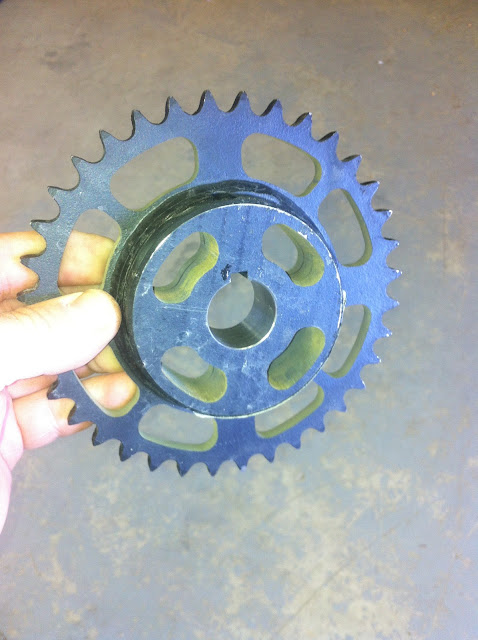This F-44SC has twin steering stations that operate twin rudders via a cable pulley system. This means that both steering wheels will turn at the same time and to link them together, a cable / chain / sprocket loop will be used. Since the fridge / freezer lies along the cabin bulkhead, I had to create a pass through that will allow the cables to run from one steering sprocket to the other. { the bolt in the photograph is NOT the bolt that will be used and is only being used temporarily for mock up purposes. All pulleys are aircraft grade aluminum with ball bearings with 9/16 stainless bolts as shafts.)
The fridge / freezer lies along the inside cabin bulkhead and the cables linking the twin steering wheels must pass through the lower. inside, aft corner. To create this pass though, I found myself needing a 6 ft. long; 2 inch diameter hole saw to use to cut through the low density foam insulation that I had previously poured in place.
a couple of minutes with a chop saw and a metal chain link fence pole resulted in a tool that I don't think I could have found at the hardware store. Using a pipe wrench , I was able to applying a little axial force and torque by hand and I was able to create a nice 2 inch hole all the way through the lower aft corner of the fridge / freezer. Since the fridge / freezer uses 6 inch thick low density polyurethane foam insulation along the sides and 8 on the bottom, this pass through hole should not compromise the insulating properties of the icebox..... especially if I seal off the air space by tucking a little foam around the cables once they are installed. If I find myself worrying about this at night, once the cables are in place, I could also fill the void with a bunch of those styrofoam beads that are inside those bean bag chairs.
Note: I intend to dine on popsicles in the noon day tropical sun, so I will do what I need to do at all cost to maintain that capability. One thing that I learned while growing up in the deep south, is that summers are much more bearable if you have a good stockpile of orange and grape popsicles.

The steering system relies upon a total of 10 pair of pulley brackets and I was able to fabricate them using aluminum angle stock, a table saw fitted with a carbide tooth blade, a drill press and a belt sander. I was able to do this without injury and without metal bits flying across the shop. As long as you plan each cut and pay close attention to keeping all cuts even and straight, life is good, If you get in a hurry and any piece of metal gets caught as a slight angle, your part will be flung into outer space after punching a hole in the roof of your metal shop. If your hands are positioned in the wrong place when this happens, it can pull your fingers into the blade and this could result in a delayed launch date.
Weight saving options:
Steel UHMW
Steel cable for steering:
 7X19 | Diameter | Approx. Weight Per 1000 Ft. (lbs) | Galvanized Minimum Breaking Strength (lbs) | Stainless Minimum Breaking Strength (lbs) |
| 3/32" | 17.4 | 1,000 | 920 | |
| 1/8" | 29 | 2,000 | 1,760 | |
| 5/32" | 45 | 2,800 | 2,400 | |
| 3/16" | 65 | 4,200 | 3,700 | |
| 7/32" | 86 | 5,600 | 5,000 | |
| 1/4" | 110 | 7,000 | 6,400 | |
| 5/16" | 173 | 9,800 | 9,000 |
Weight of 120 ft of 5/16 wire = 20 lbs with a breaking strength of 9000 lbs
~~~~~~~~~~~~~~~~~~~~~~~~~~~~~~~~~~~~~~~~~~~~~~~~~
amsteel blue steering "cables"
| DIA. Inch. | CIRC. Inch. | AVG TENSILE STRENGTH (lbs.) | APRX. WEIGHT (lbs. per 100ft.) |
| 1/8" | 3/8" | 2,200 | 0.50 |
| 3/16" | 9/16" | 5,500 | 1.00 |
| 1/4" | 3/4" | 8,400 | 1.70 |
| 5/16" | 1" | 13,200 | 2.60 |
Weight of 120 ft of dyneema = 3.12 lbs with a breaking strength of 13,200 lbs
Conclusions: Amsteel blue is about 6 times lighter and 70 percent stronger by size. In this post, stretch has not been mentioned. When using synthetic cables, it is expected that it will take a breaking in period to eliminate constructional stretch. To make this easy. dead eyes with multiple ratios can be used. It is also possible to incorporate conventional turnbuckles.














